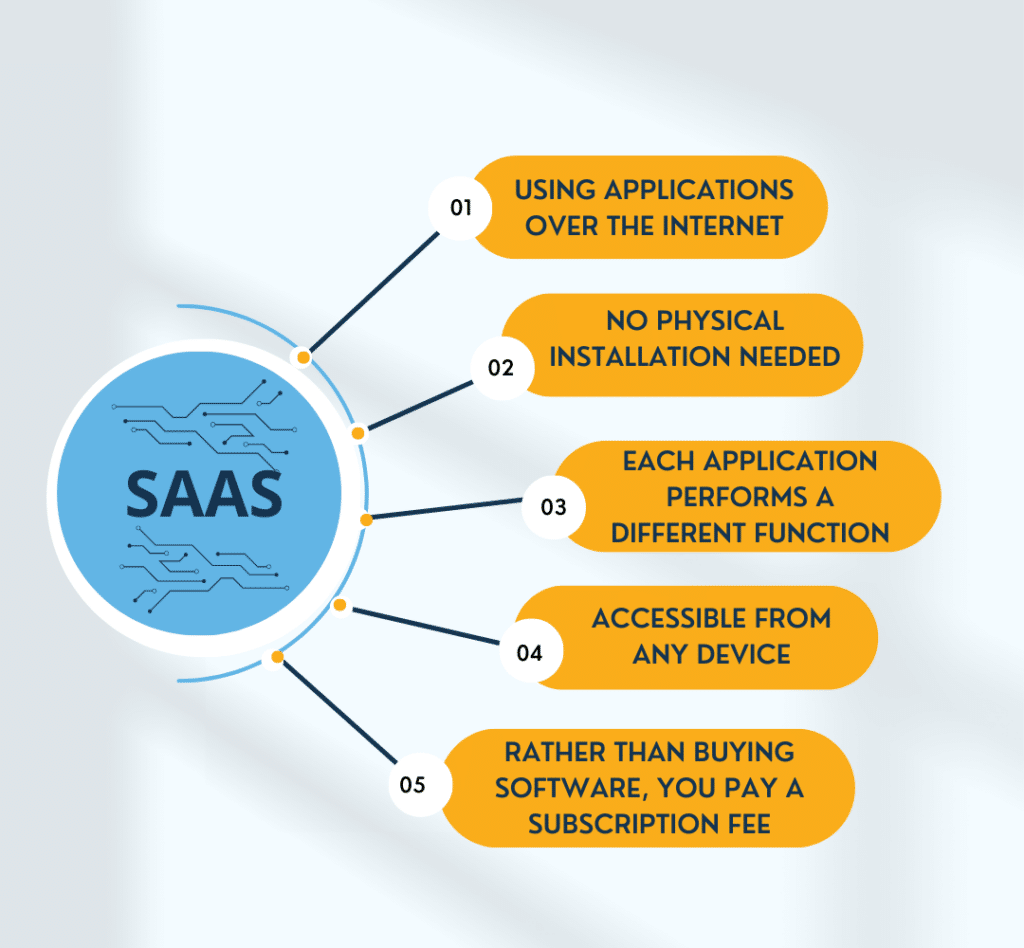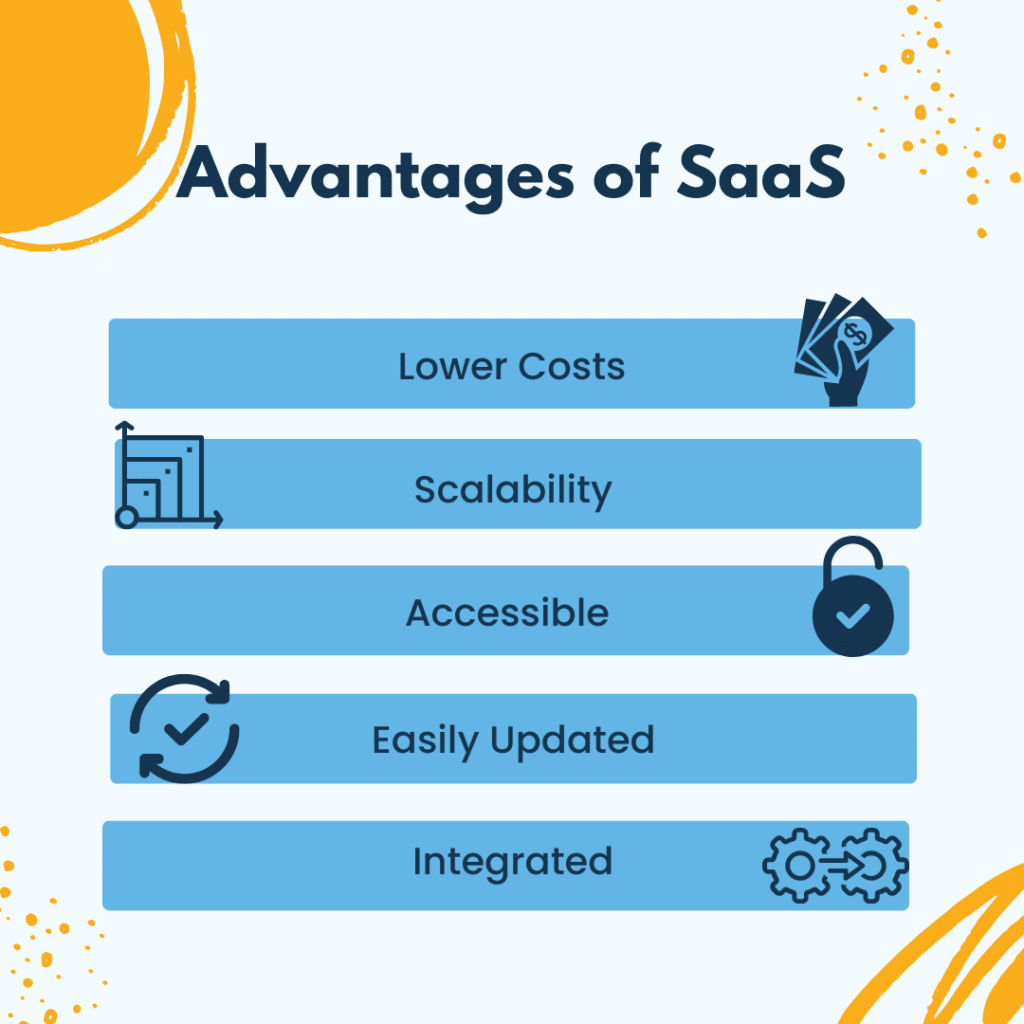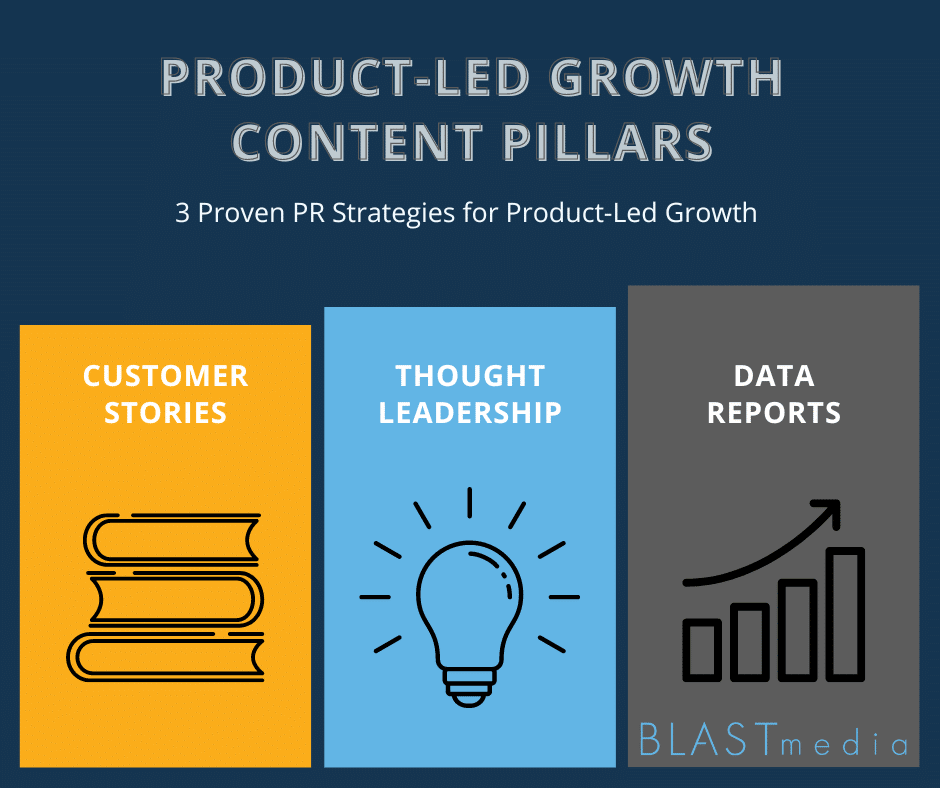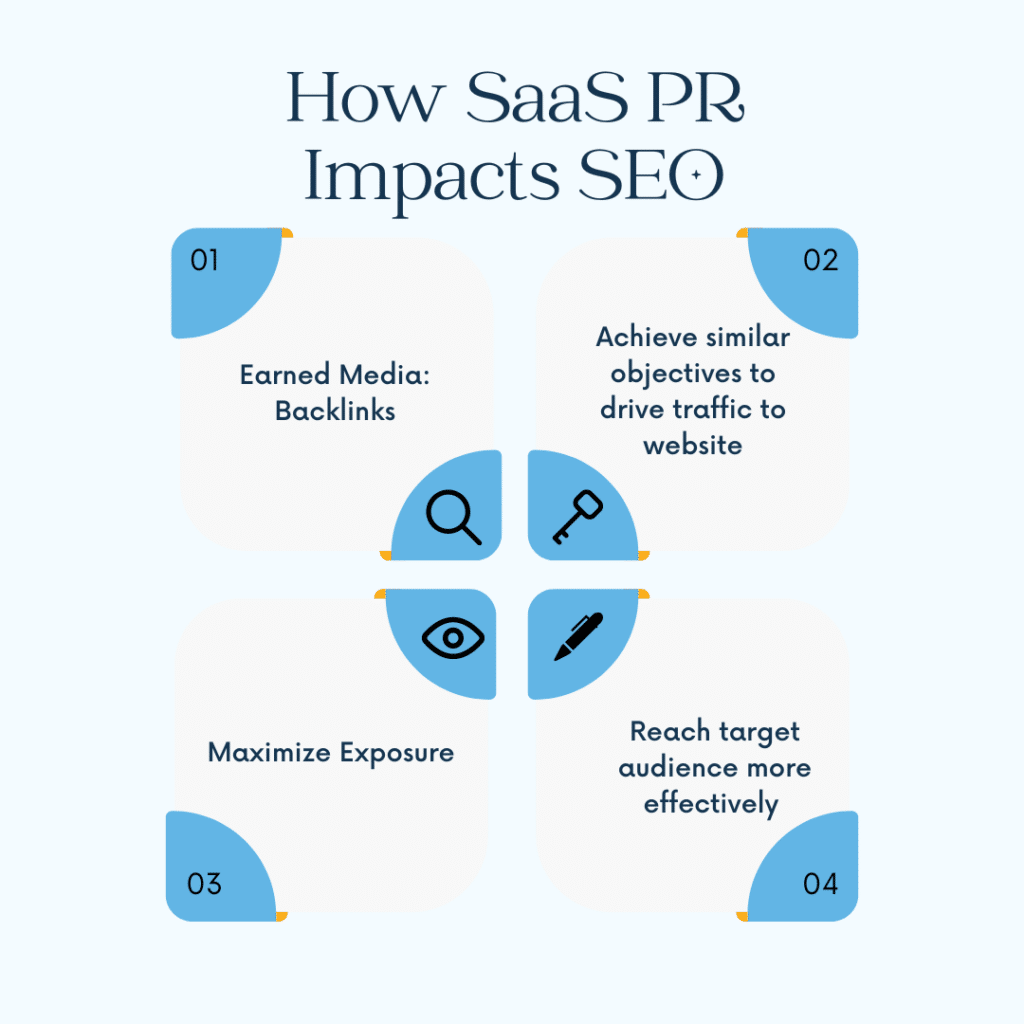SaaS PR: A Guide
This page is intended to be a knowledge base for understanding Software as a Service (SaaS) and public relations (PR).
TABLE OF CONTENTS:
What is SaaS?

Software as a Service (SaaS) is defined as a software distribution model in which a third-party cloud provider, like Amazon Web Services or Microsoft Azure, hosts applications and makes them available to customers over the Internet. Rather than selling physical products and software, SaaS companies offer their products in the cloud as a download and are primarily sold as subscription-based models. Some of the world’s most well-known SaaS companies include Salesforce, Dropbox, DocuSign, Shopify and MailChimp.
The first SaaS company, Salesforce, was born in 1999 as the mobile and internet-technology world exploded. The SaaS industry saw exponential growth in the 2000s as traditional software companies moved to the cloud, and venture capitalist firms poured money into emerging SaaS companies. The SaaS industry experienced another spike in demand when the world shut down to combat COVID-19. The pandemic response created an immediate need for on-demand, cloud-based tools to help businesses run remotely (many for the first time). While the number of B2B SaaS tools that saw explosive growth is plentiful, the most well-known are technologies like Slack and Zoom. The pandemic helped the SaaS industry surge, which TechTarget projects to grow into a $200 billion industry by 2024.

As a SaaS business scales with increasing demand, so does its marketing budget and the need to differentiate in an often crowded category. With companies doubling down on brand spend to help with this category separation, adding a SaaS PR strategy to the brand marketing mix allows brands to stand out and create a consistent narrative for external audiences.
Media Relations Supports SaaS Brands
In today’s digital world, the number of industry voices and information destinations is vast. Adding media relations to your SaaS PR marketing strategy effectively breaks through the noise and creates meaningful commentary. Earned media coverage can speak to potential prospects and impact key stakeholder pillars like investors, partners and talent.
One of PR’s greatest assets is its ability to build brand awareness. By targeting the media sources your audience is reading, watching, and listening to, SaaS PR helps your business gain visibility with the people with whom you want to establish a relationship.
According to Gartner, the SaaS buyer journey has evolved into a 27-step process from start to finish. Additionally, “[t]he buyer completes most of their purchases without engaging vendors.” This is why SaaS PR is critical, as it influences multiple stages of the funnel, not only the top, and can impact customer retention and advocacy.
SaaS PR can be a powerful tool for category creation – especially when marketing budgets are tight. By thoughtfully crafting and placing messaging around a new or emerging category, SaaS PR coverage can generate awareness and understanding of product solutions without spending significant marketing dollars. In addition, a well-executed PR strategy can also help build credibility and excitement, both of which are essential for success. When done right, SaaS PR can be a cost-effective way to make headway in category creation, aid in re-defining a category or help create category differentiation.
In addition to assisting SaaS companies to increase brand awareness and category separation or creation, a SaaS PR strategy can support a brand’s plan for financial exit.
SaaS PR’s Role in M&A
Many SaaS brands are looking to PR to influence prospects. Yet a strategic PR program can also help sway interested investors and increase attractiveness to potential acquirers. By staying in touch with key influencers and delivering timely updates through the media, scaling SaaS companies can make a lasting impression and increase their chances of securing funding or being acquired.
As you approach an acquisition, here are a few key things to keep in mind as you plan your PR strategy. Creating a PR strategy ensures your acquisition announcement is successful.
SaaS PR can also play a critical role in supporting a company’s transition to public markets. For many SaaS brands, a well-executed PR strategy can help to create and establish the category where the company competes. It can build brand awareness and position the company as a thought leader within its industry. These factors can contribute to the perception of IPO readiness, making PR an essential part of any pre-IPO planning. Investor relations firms may also recommend that companies use PR to support investor education and outreach initiatives. By raising awareness of the brand among key investors and analysts, SaaS PR can help build support for the IPO and ensure a successful transition to public markets.
Developing a SaaS PR Thought Leadership Strategy
Thought leadership is more than just having an opinion or being quoted in a press release. When thinking about who should be a thought leader, consider the following:
- Thought leaders are respected for their knowledge and insight on a particular subject and use this authority to provide valuable guidance.
- Unlike traditional experts who rely on their credentials or position to command respect, thought leaders earn the trust of their followers by regularly producing high-quality content that is both informative and actionable.
- Thought leaders can build strong relationships with their audience and establish themselves as a go-to source for information and advice.
If you want to be a SaaS thought leader, start by producing content that is worth reading. Focus on offering fresh perspectives and insights to help your readers overcome the challenges they face. With time and consistency, you will build a following of engaged readers who appreciate your wisdom and expertise.
Outside of content, you can also use your insights and expertise on podcasts. Incorporating podcasts into your thought leadership strategy provides opportunities to speak to niche audiences that truly care about the topics you speak to.

Thought leadership is a term that gets thrown around a lot, but what does it really mean? Essentially, it refers to the ability to generate new ideas that shape the direction of your industry. While that may sound like a tall order in SaaS PR, fortunately, it doesn’t require an entirely new strategy. Most B2B SaaS leaders have a wealth of untapped knowledge to make a great story. It all comes down to asking the right questions.
For example, you might ask: “What are the biggest pain points your industry faces?” Or “What do you believe about the category’s future that most people would disagree with?” Thought-provoking questions can help you identify potential topics for thought leadership content, and they’re just the start. As you explore different PR angles and take ideas further, you’ll gradually begin understanding better what makes your spokespeople unique and how they can contribute to conversations around your industry. In time, those insights will turn into actionable ideas for thought-provoking content that will help position you as a leader in your field.

If you’re a SaaS marketer who relies solely on the top brass for ideas for thought leadership, you’re missing out. There are Subject Matter Experts (SMEs) who work in the nitty-gritty and often have a better pulse on the customers’ day-to-day business and pain points. SMEs with industry-specific expertise (e.g., compliance, security, data science) are particular gold mines of information. So don’t neglect these key players when brainstorming your next thought leadership campaign. Instead, tap into their wealth of knowledge and insight by using the same techniques to uncover storylines.
How PR Impacts SEO
PR and SEO are complementary, but they are two distinctly different practices. PR is about building relationships and creating exposure for your brand externally, while SEO focuses on optimizing your website content to rank higher in search engine results. However, PR can positively impact SEO and vice versa. For example, an earned media story on a reputable media site with a backlink to your blog helps build authority and trust for your website. PR and SEO are complementary strategies to achieve similar objectives for driving traffic. Integrating PR into your SEO strategy allows you to maximize your exposure and reach your target audience more effectively.

Backlinks are one of the most important ranking factors for SEO. A backlink is simply a link from one website to another, and they play a vital role in how search engines like Google rank websites. Backlinks are used by search engines to discover new web pages and to help determine how well a page should rank in search results. So, if you have a page on your website that you want to be ranked highly by Google for a particular keyword, you can improve your chances by having other websites link back to that page. Backlinks act as votes of confidence, and the more high-quality links you have pointing to your website, the better your chances of ranking well in search results. Backlinks are essential to any SEO strategy and should be a priority for any business that wants to rank highly on search engine results pages.
A Holistic SaaS PR Strategy
While media relations is the backbone of a PR program, consider additional tactics when developing a well-rounded SaaS PR strategy. These additions commonly include speaking program management for executives, an awards program, and analyst relations.
Speaking opportunities are a great way to reach relevant customer prospects and establish thought leadership in a well-rounded PR program. Whether participating on a panel at a local entrepreneur networking event or giving a keynote at a national conference like SaaStr, speaking opportunities offer the chance to share insight with a captive audience and build relationships with potential customers. By establishing yourself as a thought leader in the SaaS industry, you can position your company as a trusted source of information and authority. Investing time and effort into securing speaking opportunities can lead to a solid PR program and increase brand visibility.

A strategic awards program is another tactic to consider adding to the PR mix. While there are company- and product-specific awards to pursue, individual awards for executives build up personal brands and create a sense of thought leadership credibility. From a “Most Influential People” award for your CEO to the inclusion of your CTO in a “Top IT Professionals” list, recognition can significantly impact how your company is perceived. In addition, these awards can help build the confidence of your spokespeople and make them more effective at promoting your organization’s message.
Product awards and company achievements – think Top Culture or Fastest-Growing awards – also give organizations third-party validation that’s extremely useful for enhancing brand perception with customers and prospects.
Analyst relations is a strategy for communicating with industry analysts who work for independent research and consulting firms. These analysts typically advise end-user technology buyers on strategic purchases. They also evaluate financial data to track market share and industry growth or help vendors better position themselves in the market by offering feedback on messaging and marketing programs. Analyst relations can be critical to a company’s overall public relations and marketing strategy. It can help a SaaS company build relationships with key players, gain insights into industry trends, and create a favorable perception of the company in the analyst community.
Measuring SaaS PR Success
The pieces are all here, but how do you measure if your PR program is successful?
We live in a marketing era driven by data. It enables us to measure PR’s impact beyond traditional vanity metrics like impressions and ad equivalences. From influencing SEO efforts through securing backlinks to supporting a client’s sales plan through executing a vertical press strategy, SaaS PR can now be tied to reaching more significant organizational sales and marketing objectives.
Just as most SaaS marketing teams work toward established Objectives and Key Results (OKRs), PR OKRs can tie PR efforts to the overarching marketing objectives. SaaS PR OKRs help you to measure the success of your media relations program in a more holistic and specific way, taking into account not only the number of media placements but also the quality and impact. PR OKRs help SaaS PR teams stay focused on chasing opportunities and developing campaigns to reach the established objectives versus throwing stuff at the wall to see what sticks.
SaaS PR trends
B2B SaaS public relations is evolving. As the media landscape becomes more crowded and competitive, the focus shifts from simply making announcement noise to creating more meaningful and consistent connections with key audiences. This link leads to a more strategic approach to public relations, emphasizing category collaboration and thought leadership.
SaaS brand marketing has also taken center stage as companies seek ways to create a differentiated identity in the marketplace. Modern PR uses more channels to amplify a message, like audio and video formats for niche audiences, providing a more engaging and intimate experience. In addition, brands have become destinations for thought leadership, with popular B2B SaaS brands like HubSpot and Drift having robust blogs featuring outside commentary and guest posts.
The SaaS PR landscape will continue to evolve as the definition of media changes and the opportunities to showcase commentary grows immensely. As long as you have a proactive SaaS PR team who stays on trend at the forefront of emerging mediums, SaaS company goals around perception and awareness can be attained through public relations.
About BLASTmedia
PANBlast is the only PR agency in the U.S. dedicated to B2B SaaS, representing growth-stage to publicly-traded SaaS companies. Check out our top SaaS PR blogs in 2022 here.

PR Services
We challenge the traditional press release-driven model and offer services to produce a balanced coverage mix of news and thought leadership to drive a consistent narrative. Our SaaS PR services help companies build relationships with key news media, generate media coverage, and create content to drive authority. PR should be an integral part of any B2B SaaS company’s marketing strategy, and we are dedicated to helping our clients achieve their SaaS PR goals.
Differentiators
We understand the unique challenges of scaling a B2B SaaS business and can offer an unmatched perspective to our clients. Our SaaS PR programs focus more on creating consistent narratives versus relying on press releases, and we are proactive at uncovering commentary and perspectives from our client thought leaders. As a B2B SaaS PR agency, we believe in using software to enhance our execution and reporting, serving data in a dashboard format familiar to SaaS marketing leaders.
Culture
At PANBlast, we are people first and weave our core values into all we do: Enjoy Life, Hustle Hard and Seek Growth. We believe a diverse and inclusive set of thoughts and perspectives creates better business outcomes and better humans — PANBlast values and welcomes all people. We are intentionally and genuinely committed to continual learning and actions, enriching our lives through diversity.
Clients
PANBlast services growth-stage and publicly-traded B2B SaaS brands across a variety of verticals.
